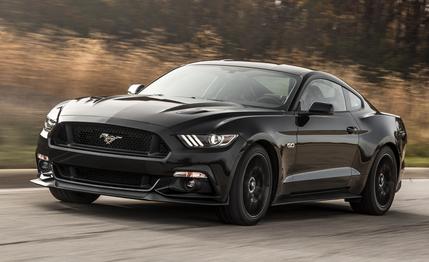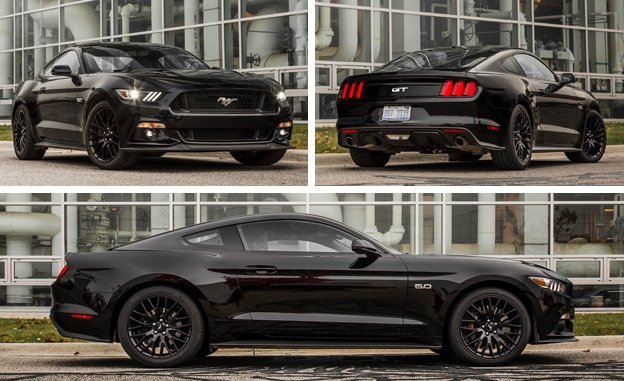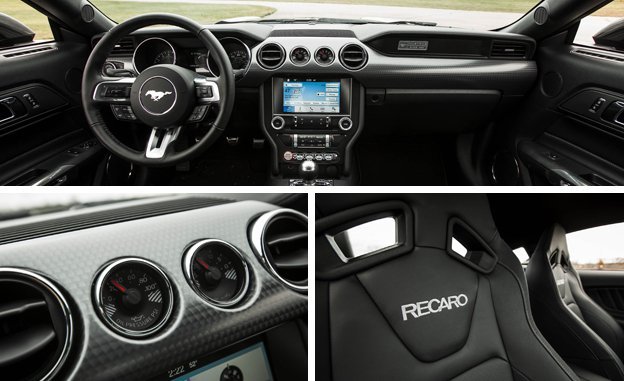
 Long-Term Road Test Intro
Long-Term Road Test Intro
Detroit’s muscle cars have experienced a renaissance of sorts lately—Hellcats, Shelbys, and Camaros, oh my!—yet it took some European-inspired refinement to bring the most out of Dearborn’s Ford Mustang. Heavily updated for 2015, which included the mainstream models’ first-ever independent rear suspension, the latest Mustang GT snagged a 10Best Cars award upon its debut and then bested the Dodge Challenger R/T Scat Pack and previous-gen Chevrolet Camaro SS 1LE in its first comparison test. Now we welcome this sinister-looking 2016 GT coupe into our paddock for a 40,000-mile shakedown.
The latest Mustang is an altogether more sophisticated thing than its predecessors, which is key for its new global mission. The ride is more comfortable and composed with the multilink rear suspension, which itself dictated a new tuning approach for the front strut setup. And the interior is more insulated and better turned-out, even if the fast rear glass means back-seat occupants will need to remove their heads before entering. Additional electronic aids, including adaptive cruise control and blind-spot warning, are now available, as is a 2.3-liter EcoBoost turbocharged four-cylinder. The car’s proportions are softer and more flowing than before, and the styling adopts much of Ford’s corporate look while still recalling Mustangs past. Updates for 2016 are limited to the addition of Ford’s much-improved Sync 3 infotainment tech on Premium models, along with secondary—and nearly invisible—turn signals integrated into the GT’s hood vents.


You can read our official breakdown of the 2016 Mustang here, as well as an in-depth interview with Ford’s development team here. But the most important thing about our test car is what makes it a GT: the 5.0-liter Coyote V-8, which develops a throaty 435 horsepower and 400 lb-ft of torque, up from the previous-generation GT’s 420 and 390. It’s not as wicked as the new Shelby GT350’s 5.2-liter flat-crank V-8, but the Coyote loves to rev and is an absolute hoot when paired with the standard six-speed manual gearbox, which is light in effort and snicks tightly through the gates. Performance figures from our test car’s initial visit to the track (after its break-in period) were strong and slightly quicker than our long-term 2013 Mustang GT’s, with a zero-to-60-mph time of 4.3 seconds and a quarter-mile pass of 12.9 at 112 mph.
While base GT fastbacks start at $33,295, our Premium coupe in Shadow Black stickered at $37,295 before options and features a host of trim and equipment upgrades: brighter interior accents, dual-zone automatic climate control, heated and cooled leather front seats, a nine-speaker stereo, selectable driving modes, ambient lighting, aluminum pedals, illuminated sill plates, heated exterior mirrors with integrated turn signals and “Pony” puddle lights, a painted rear diffuser, and unique 19- and 20-inch wheel options. That’s on top of the Mustang’s standard automatic HID headlights, sequential LED taillights, eight airbags, and the GT’s Track Apps and line-lock burnout software.
Also available on Premium versions is an upgraded Shaker audio system, voice-activated navigation, and the aforementioned driver aids. We passed on all of that but did opt for the $1595 black leather Recaro sport seats, which are snug-fitting and lack the heating and cooling of the standard chairs. They also provide the driver with the necessary support to exploit our car’s other option: the $2495 GT Performance package. That bundles larger, six-piston Brembo front brakes, a 3.73:1 rear axle ratio with a Torsen limited-slip differential, a stiffer suspension setup, a larger radiator, chassis and strut-tower braces, unique tuning for the electrically assisted steering and stability control, and black-painted 19-inch wheels with Pirelli P Zero summer tires, sized 255/40 in front and 275/40 at the rear. The bottom line: $41,290.


At the limit, our GT does have a moderate sense of understeer in corners, what with 54 percent of its 3782 pounds residing over the front axle. But that can be easily corrected with a stab of the throttle. Our test car still managed a healthy 0.94 g of lateral grip on the skidpad, and the additional traction from the sticky Pirellis kept panic stops from 70 mph to just 156 feet. The Mustang’s steering isn’t superquick at 2.6 turns lock-to-lock, yet it is precise and natural enough in feel to make you think it’s hydraulically assisted. Steering effort can be adjusted from light to heavy by a toggle on the center stack or via the adjacent switch that cycles through the selectable Normal, Sport+, Track, and Snow/Wet drive modes, which also affect the engine response and stability control.
With less than 2500 miles on the odometer, we’re still getting used to our long-termer and have yet to take it any distance from home. And the mileage accumulation definitely will take a hit soon as the Michigan winter begins in earnest. To prepare, we’ve put the Mustang on a set of Bridgestone Blizzak LM-32 winter tires.
We have yet to encounter any technical or service issues with the car, but there have been a few complaints about the limited range (260 miles) from the smallish 16-gallon fuel tank and our test car’s observed 16 mpg in the real world—well below the EPA’s combined rating of 19 mpg. The other gripe concerns the latest GT’s muffled exhaust note, which lends it a more civilized attitude at the expense of some of its rowdy character. It still has a pleasant growl, but this is a muscle car with a great V-8 engine, and it deserves to be heard. You likely can plan on us asking for a Ford Performance exhaust (or a set of exhaust cutouts like those on the old Boss 302) for the holidays.
Months in Fleet: 1 month Current Mileage: 2349 miles
Average Fuel Economy: 16 mpg Fuel Tank Size: 16.0 gal Fuel Range: 260 miles
Service: $0 Normal Wear: $0 Repair: $0
Damage and Destruction: $0